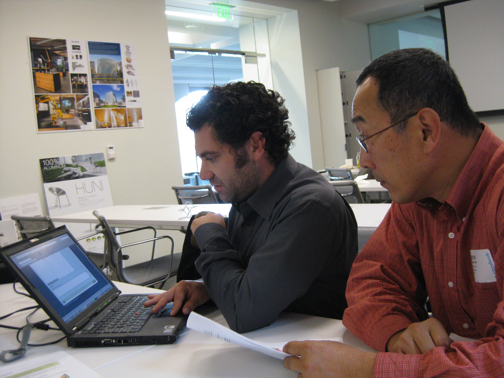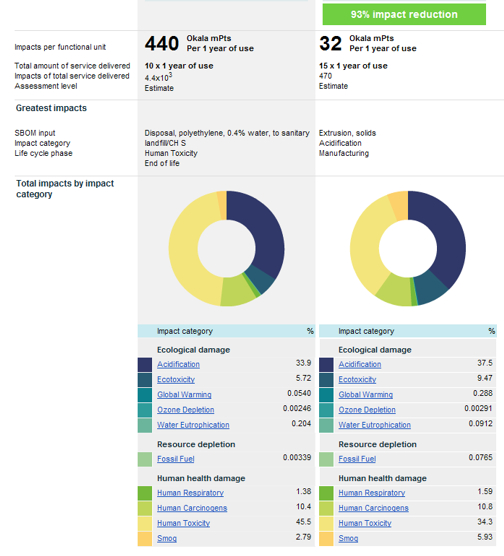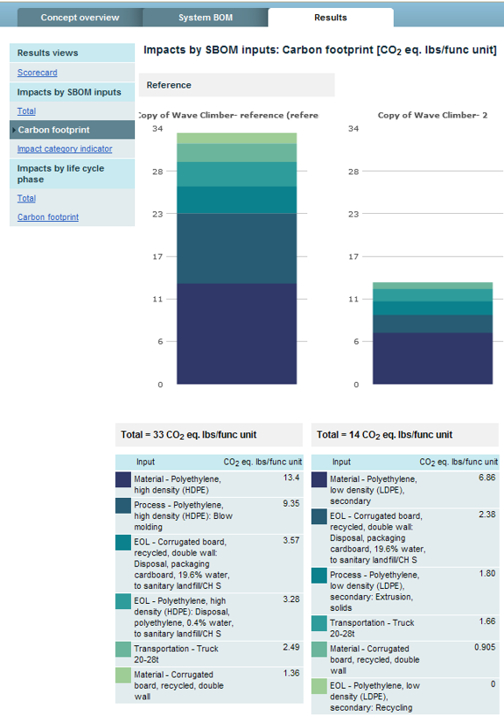Latest News
November 9, 2009

Last Thursday, I was suffering from cabin fever (an occupational hazard of working from home), desperate for an excuse to get out. So, when Sustainable Minds’ cofounder and CEO Terry Swack invited me to a design workshop in my very own city, taking place a few blocks away from San Francisco’s waterfront district, I happily hopped on a train.
Sustainable Minds is a “greener product design software and information company dedicated to bringing environmentally sustainable product design into mainstream design and manufacturing,” the company explains. Swack wants the company’s software to become “the TurboTax of lifecycle assessment.”
The software is Web-hosted, so you don’t need to download or install it. You simply point your browser to the company’s site, create an account, then start using it online (as you might, say, Facebook or Twitter). At $700 per user per year, the subscription costs about $58 a month, a reasonable expense for a small business.
The Green SquadBy the time I arrived, the class was getting ready for the hands on portion, so Swack split the attendees into several teams. My teammates were Kim Sang-Tae from Life Technologies, a global firm that develops and markets DNA analyzer equipment; Jim Hill from State of California’s Recycling Division; and Denny (whose last name I failed to jot down) from Autodesk. With cups of fresh brew coffee, a laptop (Denny’s), and a test account from Sustainable Minds, we set out to design an eco-friendly slide for a children’s playground for an imaginary toy maker.
All products have environmental impacts, stemming from the carbon and waste materials generated by the manufacturing processes and usage scenarios. Hence, Swack argues, “There is no such thing as a green product. There are only greener products.” So, to be precise, our assignment at the workshop was to redesign the existing apparatus (dubbed Wave Climber), to achieve the same purpose (let children play with it in the backyard) with less environmental impact.
To measure a product’s environmental impact, Sustainable Minds uses Okala points, derived from the Okala lifecycle assessment methodology. With this system, your manufacturing choices—materials, production methods, disposal methods, and transportation—are assigned numeric values that represent environmental impacts (the lower the score, the better it is for the environment).
A glance at the scorecard of our existing concept (or reference concept) revealed two biggest problems: human toxicity and acidification.Digging into the Learning Center (part of the Sustainable Minds portal), we discovered toxicity could be mitigated by specifying alternative materials and acidification could be reduced by more efficient energy use. So we delved into the system bill of materials (SBOM) for the next step.
System Bill of Material
Historically, CAD users think of BOM as a list of items required to produce a design. What you export out of your CAD system is just that: a catalog of standard and custom parts IDs, supply sources where they may be purchased, materials, and dimensions, recorded in some form of spreadsheet or Excel-like structure.
Sustainable Minds want you to redefine BOM. If you stretch the definition beyond manufacturing to include lifecycle needs, you’ll record not only materials and suppliers but also the distance you’ll need to transport the items and the method of disposal available to you. These input parameters are typically not found in CAD, PDM (product data management), or PLM (product lifecycle management) systems, but a necessity in calculating a design’s environmental impact.
In Sustainable Minds, the software narrows the scope of your subsequent choices to what is logical. For example, if you specify a material that cannot be injection molded and cannot be recycled, you won’t see those choices in the drop-down menu when you enter your manufacturing or end-of-life selections.
Theoretically, nothing prevents you from uploading your BOM from any CAD system—Pro/ENGINEER, SolidWorks, or Solid Edge, for example—to Sustainable Minds as an Excel file, but you need to first reformat it to match Sustainable Minds’ template. If your CAD system and Sustainable Minds don’t label materials the same way, you’ll need to redefine your materials using Sustainable Minds’ drop-down menu.
Sustainable Minds’ recent partnership with Autodesk makes this process a bit easier for Autodesk Inventor users. They can upload a BOM exported from their CAD system directly to Sustainable Minds, without having to reformat it to match Sustainable Minds’ template.
“There’s no standard taxonomy for describing [manufacturing] materials,” Swack points out. That makes the CAD-integration a daunting task for Sustainable Minds and other lifecycle assessment software developers.
Wave Climber, Round Two and Three
To reduce the Wave Climber’s environmental impact, my teammates and I went after the most obvious. We switched from high-density polyethylene to low-density polyethylene (secondary), which gave us the option to recycle it in the end-of-life phase. (When the material was specified as high-density polyethylene, our end-of-life disposal options were limited to dumping it at a landfill.) We also switched the manufacturing method from blow molding to extrusion solid, which consumes less energy. (Jim Hill, our team member familiar with manufacturing, assured us that we could, in deed, produce our parts separately using this method.)
Becoming more ambitious, we redesigned the slide (that is, we sketched out another idea) as a modular structure that can be reconfigured as a toy house (also a dog house). Sang-Tae Km pointed out we had essentially extended the lifecycle of the product, possibly from 10 to 15, so we changed this field accordingly in the SBOM.
These measures, we discovered, dropped the Okala scores dramatically. We began with 440 Okala points. In Redesign Version 1, we were down to 47 points; in Version 2, we ended up with 32 points, which represents the design option with the lowest environmental impact.

No Standard for Carbon Count
Whereas sustainability scoring in architecture has become fairly standardized, that’s not the case in manufacturing. In building and construction, U.S. Green Building Council’s LEED crediting system has emerged as the accepted standard. In manufacturing, no such scoring system currently exists.
Suppose I use SolidWorks Sustainability Xpress to obtain the carbon footprint of a part (this module currently works only on parts, not assemblies), then do the same using Sustainable Minds, I probably won’t end up with the same count, for the simple reason that the two software don’t use the same method to calculate the impact. (For more on SolidWorks Sustainability Xpress, read my previous blog post here or watch the video here.)
What to Look Forward toIn its debut release, Sustainable Minds doesn’t give users the option to print the environmental reports in PDF. Nor does it allow you to compare the results of more than two concepts at a time. These features, along with unit conversion and search functions, are slated for a future release, according to Swack.

Subscribe to our FREE magazine, FREE email newsletters or both!
Latest News
About the Author
Kenneth Wong is Digital Engineering’s resident blogger and senior editor. Email him at [email protected] or share your thoughts on this article at digitaleng.news/facebook.
Follow DE





